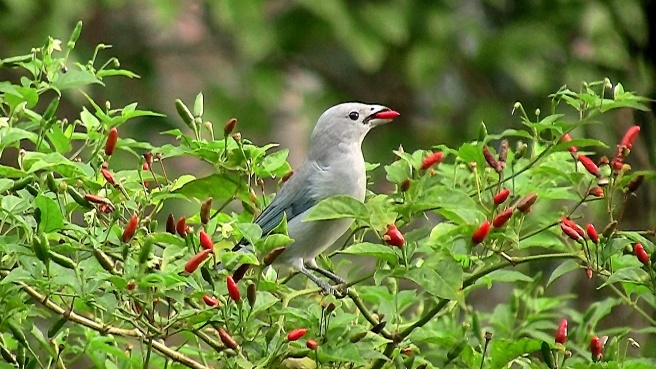
As someone who likes to play with fire in my cooking, I always have a hearty stock of chili peppers in my kitchen. Depending on the dish, I’ll use anything from canned chipotles, ground cayenne, and paprika to fresh jalapeños and habaneros. All peppers, hot and sweet, are cultivars of five species from the genus Capsicum that were first domesticated in Central and South America as early as 10,000 BCE (1). Though the spiciness of chilies is celebrated in cuisines around the world, and breeders are always competing to create hotter and hotter varieties, chili heat originated long before they were domesticated, as the result of an evolutionary battle between chilies, herbivores, and disease-causing pathogens.
The spiciness that makes people love or fear chilies is derived from unique compounds called capsaicinoids. Found only in Capsicum species (hence the name), capsaicinoids are a family of plant secondary compounds, chemicals produced by plants to deter hungry herbivores and to defend them against pathogens. Capsaicinoids prevent mammals from eating peppers, but do not deter birds. Because birds do not taste capsaicinoids, they readily consume chili peppers and disperse the seeds unharmed in their droppings, whereas seeds in peppers consumed by mammals do not survive the digestion process (2). But this may not be the whole story behind capsaicin evolution. Pepper seeds are also threatened by fungal pathogens that cause them to rot and die before they can fully develop. A study by Joshua Tewksbury and colleagues hypothesized that the evolution of capsaicinoids was also driven by the need to prevent fungal pathogens from attacking chili plants. To determine how capsaicinoids affected fungal pathogens, the researchers conducted an experiment using the wild chili pepper, Capsicum chacoense from southwestern Bolivia. Although this species is not an ancestor of any domesticated chili species, C. chacoense plants exhibit extensive variation in the production of capsaicinoids, with some plants not producing any spicy compounds. This variation makes them an ideal species to determine the potential benefits that capsaicinoids provide for chili plants.

The chilies used in the study are often infected by a seed-rotting fungus, Fusarium semitectum. The fungus is transmitted to growing chili peppers by insects from the “true bug” order Hemiptera. These insects pierce chili pepper skins, and in doing so, introduce the fungus into the peppers. This process leaves small black scars on the surfaces of peppers, which can be easily counted by researchers. In their study, the number of scars on a pepper’s surface was positively related to the degree of fungal infection in its seeds. Peppers that had the most scars had the highest rate of seed infections, whereas peppers without scars were free of fungus.
To determine whether capsaicinoids protect peppers from fungal infections, the researchers collected peppers from plants that do and do not produce capsaicinoids and compared the rates and intensity of fungal infections. This involved counting the number of scars on a pepper’s surface and scoring the level of fungal infection in its seeds by visually comparing fungus-caused discoloration of the seeds to standards. They found that the non-spicy peppers were 50% more likely to be infected than the spicy peppers. For the spicy peppers that were infected, they had 45 to 55% less fungus within their seeds compared to infected non-spicy peppers. To determine whether these differences were caused by the presence of capsaicinoids and not another factor, the researches set up an experiment in the lab, where they grew the fungus in growth media containing different levels of two major capsaicinoids, capsaicin and dihydrocapsaicin. They found that the presence of these two capsaicinoids reduced fungal growth by 49%, confirming their hypothesis that capsaicinoids protect chilies from fungal infections.
If capsaicinoids protect chili seeds from fungal infections, why didn’t some of the wild chilies used in the study produce any capsaicinoids? In a different study, the same researchers found that seeds from spicy peppers have thinner seed coats, which makes them more likely to be damaged by the digestive systems of birds that eat peppers and disperse their seeds (3). Therefore, the production of capsaicinoids presents an evolutionary trade-off: spicy pepper seeds are less likely to be infected by seed-killing fungi, but are more likely to be damaged by the birds that disperse them. This trade-off is thought to maintain both spicy and non-spicy chili peppers in C. chacoense populations.

Although the compounds that make peppers spicy evolved, in part, to defend them from hungry mammals, they are also the reason why one in four people worldwide eat them each day (1). Although the anti-mammal function of capsaicinoids seems to have backfired with humans, its anti-fungal properties may be one of the reasons why ancient South American indigenous peoples first domesticated spicy peppers. Studies have suggested that these fiery peppers were used to preserve food due to their anti-fungal properties (1). Whatever the primary reason for pepper domestication, next time you add a little of their fire to your cooking, think back on the evolutionary battle that brought the heat to your kitchen.
Works Cited
- Tewksbury, Joshua J., Reagan, Karen M., Machnicki, Noelle J., Carol, Tomás A., Haak, David C., Calderón Peñaloza, Alejandra Lorena, and Levey, Douglas J. (2008) “Evolutionary Ecology of Pungency in Wild Chilies”. PNAS 105(33): 11808-11811. http://www.pnas.org/content/105/33/11808.short
- Tewksbury, Joshua J., and Nabhan, Gary P. (2001) “Seed Dispersal: Directed Deterrence by Capsaicin in Chillies.” Nature, 412 (6845): 403. https://www.nature.com/articles/35086653
- Tewksbury, Joshua J., Levey, Douglas J., Huizinga, Meribeth, Haak, David C., and Traveset, Anna. (2008) “Costs and Benefits of Capsaicin-Mediated Control of Gut Retention in Dispersers of Wild Chilies” Ecology 89(1): 107-117 https://esajournals.onlinelibrary.wiley.com/doi/abs/10.1890/07-0445.1
